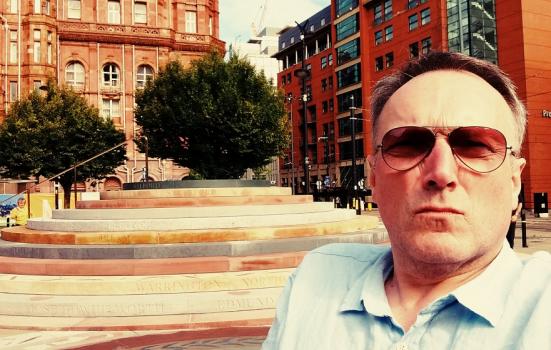Five years after first highlighting discriminatory attitudes in ArtsProfessional, the Government’s Disability Champion for Arts and Culture Andrew Miller reflects on progress towards inclusion.

When Tate Modern visitor Ciara O'Connor exploded on Twitter in August to complain about the inaccessibility of Olafur Eliasson’s ‘In real life’ exhibition for a wheelchair user, she shone a light on our sector’s institutional and artistic ableism.
Great art is for everyone, not everyone minus wheelchair users
Ciara expressed the frustration of many disabled people, sick of being told to ‘go around the outside’ of inaccessible exhibits, of having to be grateful for every small reasonable adjustment while “watching other people enjoy life, art...the way it’s ‘supposed’ to be enjoyed”.
Her eloquent anger led to an apology from Tate, a tweet from Eliasson thanking her for ‘shouting out loud’ and an article in Frieze Magazine headlined ‘Does the art world have a problem with disabled people?’
Like Ciara, I have spent my life going around the outside and largely put up with it. That changed five years ago when I first revealed in ArtsProfessional the access and attitudinal discrimination I had experienced working in the mainstream arts sector.
In that article I warned that “complacency towards disability is pitching the arts backwards. Equal opportunities remain an active battlefield for disabled people and discrimination is winning. The sector and its funders must wake up to this threat and proactively find solutions”.
Hearing about Ciara’s experience at Tate and witnessing the furore around Jeremy Deller’s monumentally inaccessible public memorial to the Peterloo massacre in Manchester, together with Dulwich Picture Gallery’s wheelchair excluding Colour Palace, one could wonder what has changed.
But I detect a shift taking place.
Central to policy
One of Thersea May’s last acts as Prime Minister was to announce the move of the Office for Disability Issues from its current home within the Department of Work and Pensions to the Cabinet Office, creating an equalities hub at the centre of Government. As one of 15 disability sector champions, this means I have a new departmental home. But more importantly, the move recognises that the issues facing disabled people in society are central to all aspects of policy and government business, and not simply a benefits matter.
This long overdue shift in thinking around disability is slowly being mirrored in the cultural sphere.
The four UK arts councils and the BFI are stepping up their work around inclusion. One of the consistent messages given to ACE during the recent public consultation on its new ten-year strategy is the importance people attach to improving diversity in the arts workforce. As a National Council Member, I’m looking forward to seeing how that aim is realised.
The Arts Council of Wales has set targets to double the disabled workforce and triple board membership by 2023 in its corporate plan. The Arts Council of Northern Ireland has committed to undertake an access audit across its funded portfolio, and the BFI has created a Disability Advisory Forum to advise and inform policymaking on film funding and influence the wider screen industry.
So there is evidence that the public funders recognise this agenda and are starting to take appropriate action. But will the sector follow suit?
More visible
Without question, disability has become more visible on our stages and screens over the last five years. From Lost Voice Guy winning ‘Britain’s Got Talent’ to Sarah Gordy starring in ‘Jellyfish’ at the National Theatre, to the first disabled-led BBC Prom by the Bournemouth Symphony Orchestra’s Resound ensemble. We’ve seen inclusive theatre initiative Ramps on the Moon win a UK Theatre Award and disabled actress and activist Athena Stevens nominated for an Olivier.
There have also been great innovations, such as the National Theatre’s smart caption glasses that help audiences with hearing loss to fully enjoy performances. The Victoria and Albert Museum regularly showcases new design practice that makes the world more accessible. And the creation of the world’s first National Disability Arts Collection and Archive traces the important history of the UK’s Disability Arts Movement.
And our disability arts sector is truly world-leading, with D/deaf and disabled artists lauded by Darren Henley as making “some of the boldest most aesthetically adventurous art out there''. Organisations such as Shape Arts, Graeae Theatre, Birds of Paradise, Tourettes Hero, Candoco and the Paraorchestra are all influencing and altering art forms in exciting ways, becoming the go-to artistic collaborators for mainstream production houses and festivals.
So representation is improving and disability steadily being mainstreamed. And yet disabled people are still near-invisible on the boards and in the workforces of our mainstream cultural infrastructure. And this absence of lived experience at a senior level is the vital missing link that enables the kind of inconsistency and exclusion displayed at Tate, at Dulwich and in Manchester. In all these cases, it appears there was no one with sufficient agency to challenge the artists about making disabled people go around the outside.
Addressing the deficit
One of my priorities as Disability Champion is to address this disability deficit in the boardroom and the workforce. This starts by improving the low level of employment of disabled people in the arts – currently languishing at 5%, according to the most recent ACE statistics.
I believe this can be achieved through better training opportunities and improved access to administration and backstage areas, to make our sector more attractive to the disabled workforce. In this, I am encouraged by ACE’s recent announcement that three projects designed to develop disabled leadership will be funded from the new Transforming Leadership programme.
But we’ll need to go further. I want to explore how National Lottery capital funds can be better used to adapt arts premises for disabled employees. And whether a statutory instrument such as an Inclusive Cultural Strategy can establish industry standards across governance, employment, training and access, to outline the expectations of arts organisations in return for public subsidy and enshrine the rights of disabled audiences. The ambition must be no less than to make our arts and cultural industries the most accessible in the world.
Progress towards this is already underway. I’ve long called for the creation of a single free National Disability Arts Access Card, designed to build disabled audiences and create a consistent offer of discounts and customer service across the funded network of arts venues and museums. A feasibility study is set to be commissioned by all four UK arts councils working in partnership with the BFI.
Paradigm shift
While there is currently positive momentum for change, risks and barriers remain. Disability still gets marginalised in the wider inclusion debate. All too often I attend parliamentary or arts sector events where healthy commitments to inclusion are made, only for disability to be entirely invisible from the platform and the agenda.
We are still largely dependent on our non-disabled colleagues giving something up: to employ us, to appoint us to the boardroom or to make a reasonable adjustment. That for me is the very definition of ableism and it is essential this paradigm shifts for good. By the same token, I believe inaccessible art like that offered by Tate, Dulwich and Manchester that excludes disabled people should not benefit from public funding. Great art is for everyone, not everyone minus wheelchair users.
Before I wrote in ArtsProfessional five years ago, I was oblivious to the fact that I was the first (and so far only) major venue manager in the country to use a wheelchair in an industry where disability was largely invisible. That article proved to be a career turning point which alerted me to the significant adjustments the sector still needed to make.
And like Ciara, I’ve chosen to no longer go around the outside, and instead work on the inside with government, funders and the sector to alter the rules of engagement.
Andrew Miller is an arts consultant and broadcaster. He is a National Council member of Arts Council England and The Arts Council of Wales, a trustee of Welsh National Opera and The Space, Chair of the BFI Disability Advisory Forum and Disability Advisor to the Paul Hamlyn Foundation. He is also Government Disability Champion for the Arts and Lifetime Achievement nominee at the 2019 National Diversity Awards.




